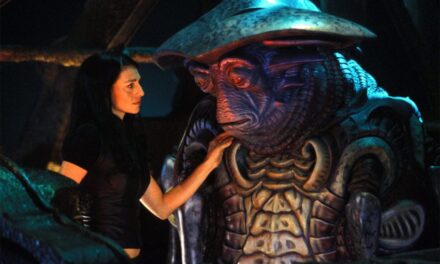“After the agony in stony places/The shouting and the crying/
Prison and Palace reverberation/of Thunder of spring over distant mountains.”
T.S. Eliot, The Wasteland
Midway in our journey through Matt Weiner’s The Romanoffs, at the end of Part 1, we found ourselves in Olivia Rogers’ special Romanov Hell. In episode 3, Olivia, an actress subjected to a deadly combination of disorientation, manipulation, and the pressure of the mythological scene of the death of the Russian imperial family, becomes for the audience a touchstone of Weiner’s large vision of temporality. She is a site of the disaster of our general confusion about our place in history and about history as a concept. But her death does not serve to completely define the way the discourse around the Romanovs makes possible a perspective on temporality in human affairs. As the series unfolds, there emerges another, more positive aspect of the human sense of time past, present, and future, with respect to Romanov history.
In “Panorama,” episode 6, Abel (Juan Pablo Casteneda), a Mexican journalist, becomes an antipodal, complementary moment of truth for Weiner’s overarching conceptualization. Abel, whom his editor, Frank Sheffield (Griffin Dunne), correctly sees as more of a poet than a reporter, becomes subject to a very different Romanov magic. Investigating what he believes to be fraud in an upscale clinic of last resort in Mexico City that caters to extremely rich people sick with incurable disorders, he unexpectedly arrives at a vision of Mexican history as a timeless, simultaneous fusion of all the events of a culture, a timeless present, because of his encounter with a possible Romanov.
Abel’s zeal for unmasking the chicanery at the clinic is tempered by his knowledge that most of the patients are super-rich predators who have acquired their wealth by inflicting all kinds of horrors on others, arms dealers and the like. One exception is the beautiful Victoria Hayward (Radha Mitchel), a purported Romanov, and her appealing, precociously wise son Nicky (Paul Luke Bonenfant), about 12 years old, who are at the clinic hoping against hope to find a cure for his hemophilia, the congenital diseased passed through the Romanov line. Of course, Victoria believes she is responsible. But is she? She’s a Romanov, perhaps, but we can’t be sure of that just because of Nicky’s disease; there are people of varying backgrounds who suffer from hemophilia. Victoria’s assumptions are another example of the way unfounded beliefs may exercise power.
And so is Abel’s mesmeric attraction to her after she tells him she is a Romanov descendent. Both predator and victim, this “Romanov” simultaneously enthralls Abel and lives in fear of her American husband, whom she has disobeyed in coming to the clinic. He, as suspicious as Abel of the clinic doctors, had not wanted her to try their methods. It’s all very iffy. She pays a very high price for treatment that fails, at the same time that Abel never succeeds in gathering enough evidence to unmask the clinic as the den of charlatans. But something incontrovertibly does happen when Abel succeeds in bringing Victoria and Nicky out of their seclusion, between Nicky’s treatments, in the luxurious hotel that the average Mexican cannot afford, when he takes them to see the monumental mural painted by Diego Rivera, the people’s artist, on the wall of the Palacio Nacional.
In brilliant colors, Rivera’s mural highlights the histories of the many exploitations of Mexico and its culture, from the ancient Aztecs through the conquistadores, to the modern oppression of Mexico and the struggles of Mexican workers and artists to regain sovereignty and dignity. The artwork sheds its powerful poetry on Abel as a Mexican struggling with national identity, but also on his relationship to Victoria. She exists in the glow of Rivera’s mural as an empress of white European privilege, from which Abel cannot liberate himself. At the same time, their final embrace, when Victoria makes it clear to Abel that there is no future for their relationship, seems to catapult Abel’s poetic sensibilities to a new level of rapture. As he departs from her, the familiar city streets of Mexico City are rendered strange.

The Romanoffs, episode 6 “Panorama”: Abel, Frida Kahlo, Diego Rivera and other iconic Mexican historic personae
Abel suddenly is surrounded by a vision of the diverse images of Mexicans through time in Rivera’s mural, embodied and walking around him, creating an eternal present in the street, as they do in the mural. Has Abel’s experience of Victoria in all her complications enabled him to make a discovery about his own culture, perhaps more important than what an investigative reporter might turn up? Are we witness here to a moment that recalls Hiroshima, Mon Amour (Dir. Alain Resnais, 1959)? In that film, a French actress and a Japanese architect achieve a transcendent knowledge of the bombing of Hiroshima in his country and her post-war punishment in France as a Nazi collaborator because of her affair with one of the German soldiers. Resnais suggests that their brief union has enabled for them and for us a vision that is born of nerves, sensuality, and vision that conveys more about history than would be possible in the rational logic of the anti-war film, in which the actress stars, about the bombing of Hiroshima. In his own way, Weiner suggests the same about Victoria and Abel.
The combination of Episodes 3 and 6, amplified by all the other episodes that precede the series finale, set the stage for Episode 8, “The One That Holds Everything,” which brings to a crescendo our apprehension of the disorientation, suffering, and ecstasy that is history, made possible by Weiner’s complex tracing of the strange byways through which the Romanov myth has travelled. The story of the last episode is about the revenge of Simon Burrows (Hugh Skinner), a “Romanov” who may have been horribly victimized from childhood by his nanny, Ondine (Hera Hilmar). Simon fervently believes that Ondine killed his adored mother, married his oblivious father, and raised Jack ( J. J. Feild), her own son—who was utterly innocent of what Simon is convinced is his mother’s treachery–to supplant Simon not only in his immediate family but as the inheritor of the Romanov legacy, such as it is. But the series does not permit us the comfort of Simon’s certainty.
Weiner uses the labyrinthine coils of time in this episode to crown The Romanoffs with a climactic moment in his meditation on the way we acquire information about and knowledge of the past. As we deal with Simon’s personal history, we are able to glean knowledge only through stories within stories told by diverse characters. We have little direct knowledge about Simon and no way of judging his obsessive lust for revenge. At the same time, episode 8, also startles us with some sudden realizations about the time frame of Weiner’s eight episodes and shakes our confidence in the security of our assumptions, of which more soon.
Episode 8 begins as Jack Edgar, a television writer, arrives at the railroad station in Paris to take a train to London where his mother and fiancée will meet him. On the train, he meets a woman who introduces herself as Candace (Adèle Anderson), a peculiar, tiresome, garrulous middle-aged passenger, who, after she is informed that Jack is working on a television series about the Romanovs, insists on rambling on about a Romanov she knew. Yes, it’s that same television series based on Reese’s book, the one that killed Olivia Rogers, and we precipitously realize that we have seen Jack before out of the corner of our eyes, on the set of “House of Special Purpose.” Indeed, his name is on the script that Olivia looks at when the episode begins. Now, Candace tells Jack a story about Simon Burrows. It’s not a story she appears to know through direct contact, but rather through second and third hand accounts. As Candace gossips about Simon, she retells the story that Simon told his therapy group about his life, after he tried to commit suicide when he is jilted by the man of his dreams. Within her second-hand account of Simon’s confession to his group is nested a third hand account of what Simon tells his group about the narrative of Simon’s many troubles that his ex-lover, Christopher (Christopher Goh) reported to his fiancée.
Climactic spoiler! It ultimately becomes clear to us and to Jack that Candace is his half-brother, Simon, who has undergone a transsexual change; and has accosted Jack as part of a plan to both get revenge on his step-mother Ondine and reclaim his Romanov legacy. What Simon/Candace said is mostly a first-hand account. The one exception is the story told by Christopher. But that is a huge exception. How could Simon/Candace could have known what Christopher said to the girl for whom he left Simon? Moreover, the knowledge, such as it is, comes cruelly late. Jack is already dying of the poison with which Candace has laced his drink. After he dies unnoticed, Simon/Candace ransacks Jack’s luggage for the material legacy that Simon/Candace is determined to make her own, a gift Jack is carrying to give to his fiancée, a pair of spectacularly large and glittering earrings that were reportedly a present to his Romanov mother’s family from the Tsar. Throughout the byzantine narrative, these earrings have appeared as all Simon has left of his mother, and a fragment of his gender identity. He has always wanted to wear them himself. As he gets off the train, Simon/Candace walks right by Ondine and Jack’s intended, who have come to meet Jack’s train, and Ondine neither recognizes her as Simon, nor notices that she is wearing the earrings Ondine has withheld from Simon all these years. Or at least Simon/Candace says that’s how it was.
These temporal disjunctions serve to unmoor us completely from any complacency we may have had about narrative, history, and time in episode 8 and in the entire series. We know that Candace has killed Jack and made off with the earrings, but can we trust Simon/Candace’s version of his life? Did Ondine really set the fire that killed Simon’s mother? Did she really scheme to cut Simon off from his father? Were the earrings really from the Tsar? Did she invent Christopher’s story? In many ways even more stunning is the sudden shock of recognition of what is happening to our own sense of time. It suddenly becomes clear that this episode precedes episode 1, and Greg and Hajar’s romantic union, when, as Jack enters the railroad station, we see Greg and Sophie leaving it, together, clearly a couple in this moment. Of necessity, it must also strike us that “House of Special Purpose” also precedes the first episode. Jack dies before Greg meets Hajar, but was still alive and on the set when Olivia died.
In this brief two-part analysis, I have not been able to give as much attention as I would like to all the episodes, but I hope I have made the point that their totality establishes a stunning, new historical paradigm. Episode 1 is not the beginning. Is episode 8 the end? Do we know when the story of Amanda’s child with Daniel Reese in episode 4, “Expectation” takes place in relationship to episodes 8, 1, and 3? In the final episode of the series, The Romanoffs soars into metatextual space. We are as disoriented in understanding the series as we are in tracing the flow of the Romanov legacy. The relative time frames of the rest of the episodes of The Romanoffs suddenly fly into the air like unanchored fragments. What do we understand about time from the order in which the episodes have been presented? Did Daniel Reese give a lecture based on The Romanovs: The Savage and The Strong in episode 2 before or after the events relating to the televising of his book? Where do “Panorama” (6), “The End of Line” (7), and “Bright and High Circle” (5) figure into this continuum? We can’t know. In each episode characters from other episodes are either mentioned or shown, but they appearances don’t necessarily give us a way to understand how events begin and end.
The eight episodes together, both in their individual narratives and in how their narratives relate to each other obliquely speak of history, poetry, and truth. A triumph of extraordinary storytelling! But that’s not how the marketers presented the series. The show is touted on IMDb as, ”A contemporary anthology series set around the globe featuring eight separate stories about people who believe themselves to be descendants of the Russian royal family.” There is nothing about this blurb that reveals the beauty and originality of The Romanoffs. And I have seen no other remarks about Wiener’s series that do. Public relations and public discourse are to the series what Daniel Reese’s book is to Romanov history and the opposite of what Abel was to the moment when the art of Diego Rivera fuses with the Romanov myth embodied in Victoria. T. S. Eliot showed us fear in a handful of dust. James Joyce, another literary pioneer, marked a new moment in cultural history when, as a founder of literary modernism, he said that history is a nightmare from which he (as a poet) is trying to awaken. The Romanoffs is similarly trapped within the public relations nightmare created by the marketers instead of being visible as the work of art in the tradition of Eliot and Joyce that it is.
Martha P. Nochimson‘s ninth book, Television Rewired: The Rise of the Auteur Series will be published on July 15, 2019. Her earlier work includes The Passion of David Lynch: Wild at Heart in Hollywood; David Lynch Swerves: Uncertainty From Lost Highway to Inland Empire; and Dying to Belong: Gangster Movies in Hollywood and Hong Kong. She has taught at the Tisch School of the Arts (NYU), and she developed and chaired a film studies program for Mercy College. Currently, she is teaching at the David Lynch Graduate Program in Cinematic Arts. She has covered the New York Film Festival for 18 years, and has also covered the Istanbul International Film Festival and the Montreal Film Festival. She is a long-time member of the Columbia University Seminar on Cinema and Interdisciplinary Interpretation.







